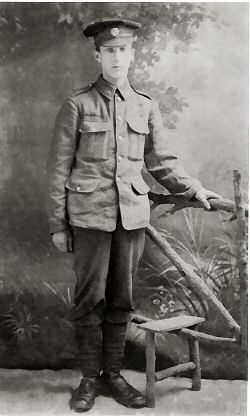( Photo is of William Lewis May)
Recently at our local history society meeting, here in Netley Abbey, Hampshire, we had a talk about the First World War (WW1). Afterwards my wife Betty spoke to the lecturer about a distant relative, who enlisted early, at 15 years old and who was killed at the battle of Loos on Saturday 25 September 1915, when he had just turned 16 years we understand. This very knowledgeable gentleman said he would research the name and report back to her. In a few days he was able to tell us that William Lewis May, a Bideford lad, had joined the 8th Battalion of the Devonshire regiment and was killed in action during the attack on the Breslan Trench, on the first day of the Battle of Loos. Further, thanks to the kindness of Betty’s aunt Lily, formerly of Westleigh, we are in possession of his medals and death plaque, together with a more detailed account of his last battle.
It was also suggested that, as we live very near a WW1/ WW2 Military Cemetery here in Netley Abbey we might like to visit the grave of another Devonshire Regiment casualty Private J Walling, who died on 24 September 1916 and who also came from Bideford.
The Military Cemetery at Netley Abbey was a part of the largest Military Hospital ever built to care for the wounded and sick of the wars being fought by our troops abroad. Opened in 1863 as a direct result of Queen Victoria’s insistence that her soldiers fighting for her abroad, should have proper and better hygiene and treatment, as more soldiers were dying of disease and poor treatment than in battles, it was claimed. At this point Florence Nightingale became involved, and was asked to suggest how this new Military Hospital might be built to take into account the above problems. It seems however that not too much notice was taken of her suggestions because the hospital buildings were too advanced in construction for them to be incorporated. The Royal Victoria Military Hospital played a major part during WW1 and WW2, but was allowed to become derelict, finally being demolished in 1966. All that is left is the Chapel building, now a visitor centre and viewing tower.
We wonder if any of J Walling’s relatives still live in Bideford. We already know those from William Lewis May’s family; as they may like to know that on the very few occasions each year we walk around the war graves, we pause at Pte. Walling’s headstone, just for a quiet moment with him.
John and Betty (Nee May) Lawrence
3 June 2010
We wonder if any of J Walling’s relatives still live in Bideford. We already know those from William Lewis May’s family; as they may like to know that on the very few occasions each year we walk around the war graves, we pause at Pte. Walling’s headstone, just for a quiet moment with him.
John and Betty (Nee May) Lawrence
3 June 2010
———————-

